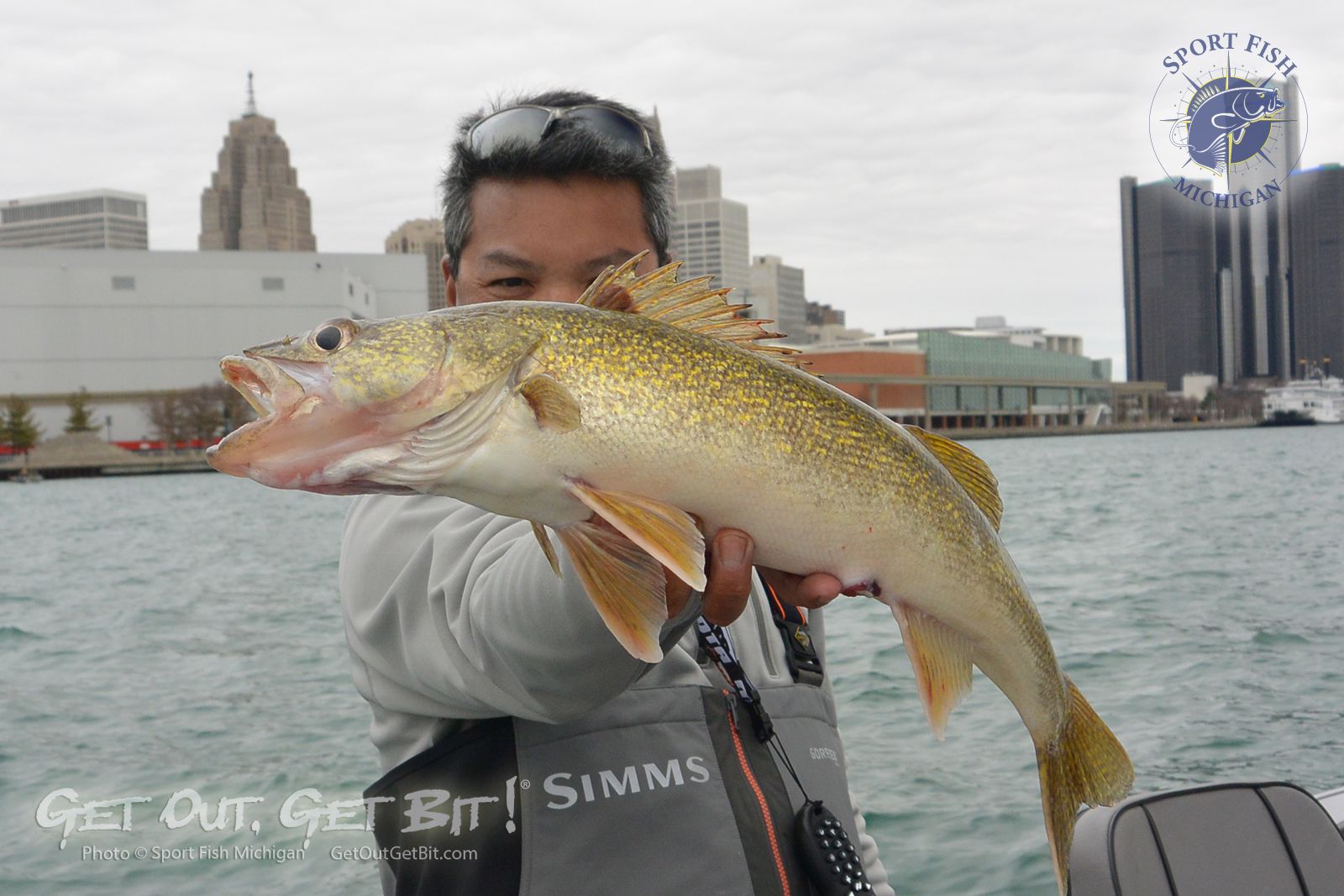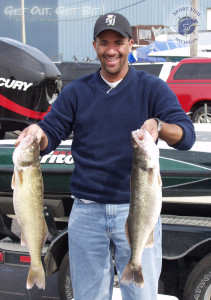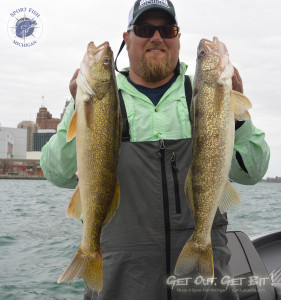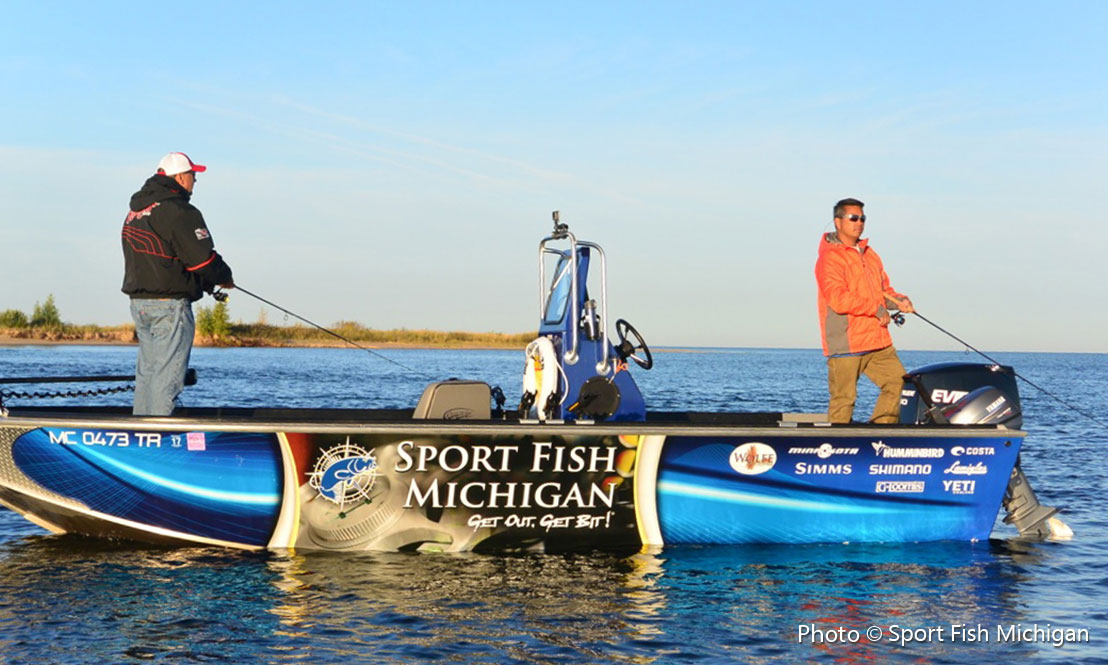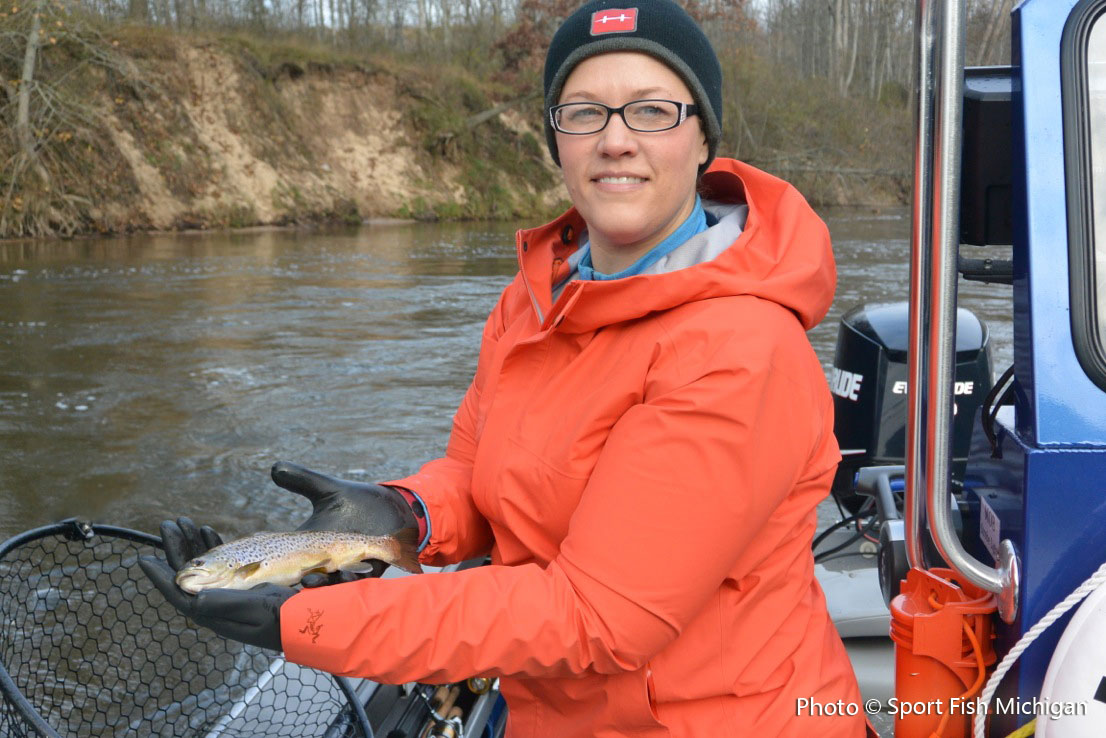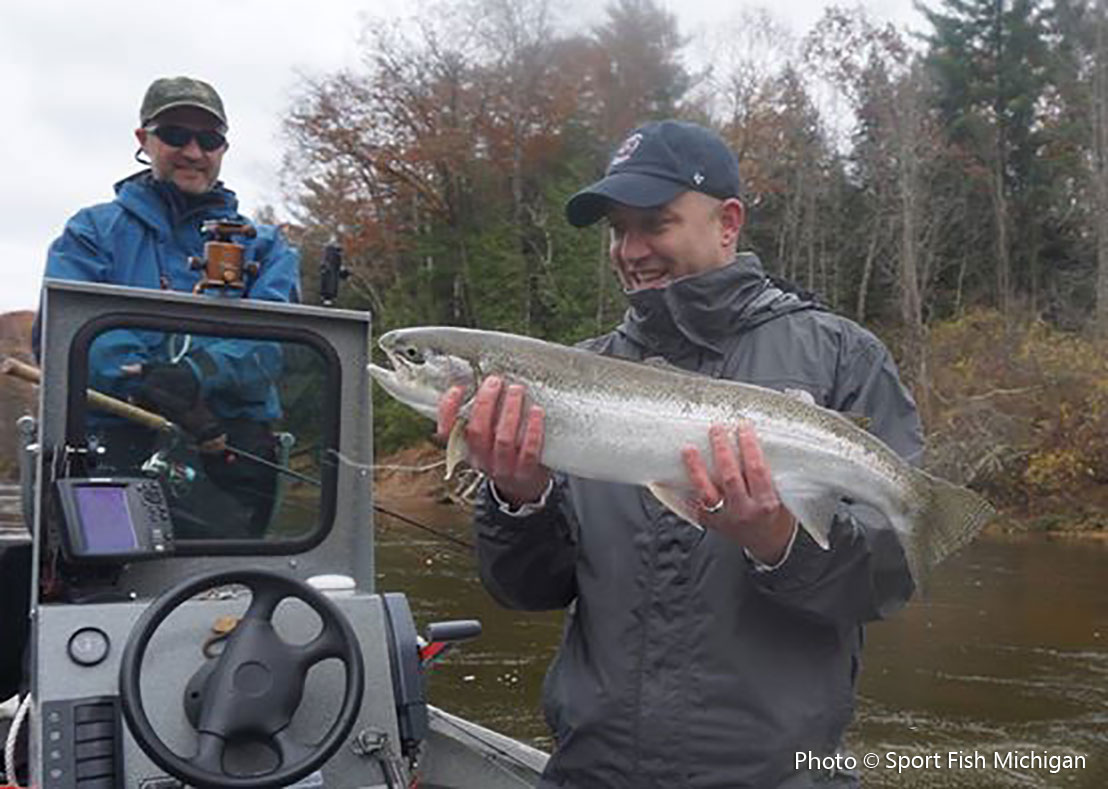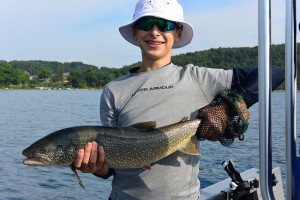
Salmon and Lake Trout Trolling
Frankfort
Frankfort’s salmon fishing has been hit or miss lately for most of the charter boats. Salmon have shown up in waves, and when they do, they have been incredibly snappy, with lots of happy customers and anglers alike. Meat rigs and spoons are the keys to getting salmon to go, and first light and last light have been the hottest times to be on the water. Anglers arriving after first light have often missed the best salmon bite. Kings continue to dominate the salmon catches, but a few coho are being caught as well. By far, the most consistent fishing has been the lake trout fishing, with lots of big fish coming boat-side. And with a diet consisting more and more of gobies, the lake trout meat is a beautiful orange hue, very closely resembling that of salmon. Lakers are being taken both close to bottom and suspended. Anglers targeting “the bank” have done well when the salmon are around, but many are making the run to fish west Platte Bay to specifically target the lakers.
Capt. Andy Odette
Leland
Leland’s fishing has been an up and down roller coaster much like Frankfort’s. When the pockets of king salmon have come through, the fishing has been stellar. The recent few days of hot steamy weather has shut things down salmon-wise a bit more than anglers would prefer, after several days of hot fishing. Lake trout fishing has been curiously inconsistent as well, but what fish are being caught have been dandies. Fishing tight to bottom has been the most productive, but targeting suspending fish has also scored fish throughout the day.
Capt. Brady Anderson
West Bay
West Bay in Traverse City has been mostly consistent the past several days. The hot weather the past few days has pushed the fish deeper, but the salmon are still staged around the “hole” near the mouth of the Boardman River. Trollers have done well when hitting the first light of day. Lake trout fishing remains awesome, fishing suspended fish in about 80 feet of water. Not only are fish seemingly plentiful, they are running fairly large, too.
Capt. Brady Anderson
East Bay
East Bay salmon fishing has been consistent lately, but not fast and furious. Charter boats are getting anywhere from 2-5 fish a trip, but are hoping for better numbers of king salmon to move into the system in the upcoming days. Lake trout fishing remains red hot, with lots of big fish coming to the boat. Targeting suspended fish is the key, and 80 feet down seems to be the best depth right now. As always, when fishing for king salmon, the hottest bite is either the first light of day or dusk right before last light in the evening.
Capt. Adam Collett
Salmon and Lake Trout Jigging
Platte Bay
Platte Bay is still fishing reasonably well for lake trout. There are lots of smaller sub-legal fish in the system, which means that when these schools are found, it can be nonstop action. Even the smaller 16-18 inch trout pound an ounce and a half jig incredibly hard. For targeting larger keeper-size fish, the deeper breaks have been the ticket. Coho salmon are starting to show, just not in great numbers yet. The forecast has some north wind for the next couple of days, and that may be all that’s needed to bring in more of these awesome fish where we can target them with jigging techniques before they get up shallow in their staging area just outside the mouth of the Platte River. Fishing in the Sleeping Bear Dunes National Lakeshore is a special opportunity, and with such a wonderful backdrop of the Dunes and the Manitou Islands, who couldn’t help but love to fish out on Platte Bay?
Capt. Ben Wolfe
West Bay
Jigging for lake trout has been great the past couple of weeks. Fish are mostly deep now that summer is finally here in earnest. The past few days of hot weather has really made it pleasant to be out on the water. Lakers have been scattered depth-wise, but the best jigging bite has been in 105-120 feet of water. Use 1-2 ounce jigs to target lakers that deep. Salmon are starting to show up in the “hole” near the mouth of the Boardman River, meaning that jigging action for king salmon should be heating up soon. Jigging spoons up to 3 ounces are the keys to getting bit by the big king salmon that roam these waters.
Capt. Brady Anderson
East Bay
Jigging for East Bay for lake trout has been stellar lately. Of course, not every day can be a banner day, but the action has been great overall. Not only are numbers of fish coming to the boat, but the average size has been tremendous as well, with quite a few fish in the 6-8 pound range. The best bite for our trips has been in 105 plus feet of water. Early in the day, we have been able to get good numbers of fish in as shallow as 80 feet as well. As the day progresses, we have moved deeper, as the trout have moved to deeper water as well. We have even been able to target suspending fish by either dropping our ounce and a half size jigs down to them, or reeling up quickly through the water column, triggering aggressive bites from the suspending fish. There’s nothing quite like reeling up from the bottom quickly only to watch the rod double over as an aggressive lake trout grabs the jig as it comes by! Whitefish have also been caught on occasion, adjacent to the lakers, in 100 plus feet.
Capt. Ben Wolfe
Michigan River Fishing
Big Manistee River (Lower)
King salmon are starting to show up on the Big Manistee River, and angling pressure is increasing as well. Although there aren’t big numbers just yet, the recent rain should pull more fish into the rivers, and the north winds predicted for the next couple of days, although not predicted to be high, should bring some more fish into the staging areas of Manistee Lake. Trout fishing remains excellent, despite the late August date! Small spinners have produced well on recent guide trips, and 50 fish days are still possible. Although most of the fish are small 10-12 inches, they are scrappy and a lot of fun to catch. Larger fish in the 16-18 inch range are also being caught, mixed in with the smaller ones. Bass fishing on the Manistee has been tougher lately. Soft plastic jerkbaits have been the ticket for the smallies in the river the past few days, as have been weighted flies resembling minnows.
Capt. Ben Wolfe
Betsie River
King salmon have started to run the river, and what fish are in the river are mostly above the Homestead dam. The heavy rains yesterday should bring more fish into the low portion of the Betsie, below the dam. The fish are bright chrome and feisty, so beefing up on leader material is a good idea. Early salmon will absolutely chase a streamer when presented well, and watching a bright chrome king salmon chase a fly in shallow waters like the Betsie is tough to beat! Some of the best stretches are reached by boat, but then can be waded easily.
Capt. Jeff Mallory
Platte River
There haven’t been any cohos that have run up the Platte to speak of, but there are still walleyes in Loon Lake, in the Sleeping Bear Dunes National Lakeshore. With the summery weather the past few days, tubing and kayaking action on the Platte has picked up, so anglers should be watchful for tubes, kayaks and canoes. Labor Day weekend will be busy if the weather is nice, so it may be best for anglers to go early in the day if they plan on getting out before the crowds.
Capt. Jeff Mallory
Michigan Smallmouth Bass Fishing
Grand Traverse Bays
Smallies are mostly deep these days, as the summer pattern is here in earnest. Drop shot rigs are the top producers when fishing this deep, and baits resembling gobies are working the best. Deep water here means fishing down in 30 plus feet of water. Windy weather helps to get fish active up shallower, and lures like spinnerbaits can work well when the wind is howling. The past several days have been hot, and while there has been some breeze, it has not been windy enough to really even try to target shallow fish. The deeper fish have been scrappy and fun to catch for guide trip customers. While the average size is a respectable pound and a half or so, there have been a reasonable number of fish in the 3-4+ pound range to make for extremely happy clients, despite the fact that it is late August.
Capt. Ben Wolfe
Northern Michigan Inland Lakes
Most of the inland lakes are fishing tougher than we would like. Lots of weeds makes fishing tougher still, as lure choice plays a role in that baits must get down through the weeds to the deeper waters where the bass roam in the summer. Early mornings can still be topwater time, fishing over the weed edges. Points, inside turns and humps adjacent to deep water are the keys to success on the inland lakes, and don’t be surprised when a pike or two lashes out at bass baits ripped through the weeds.
Capt. Ben Wolfe





